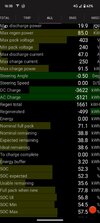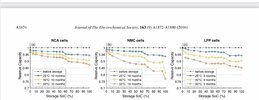And the data and calendar ageing formula for LFP is similar?
Yup.
All research results is from cells at least a couple of years age. Getting the hand on, testing for 1 year and writing and getting the report approced takes about two years in total. In some cases more, if the test protocoll takes more time.
But we can see that LFP in the RWD Teslas seem to degrade about as much as the other chemistries and about as much as expected from the test result we have.
All lithium ion chemistries behave about the same. And a specific chemisty will probably continue to behave about the same even if its tweaked and the total degradation might be slightly lower.
The reason that we can see about the same, maybe slighty less degradation on RWD cars with LFP is because they degrade as usual or about as usual from calednar aging. If they did not, we would se almost non degradation at all, as the cyclic degradation is very low with modern LFP's.
Is 100% indicated by the BMS for LFP or NCA the actual 100% for the battery?
Yes, Tesla use 4.20V/cell as 100%, which is the branch standard. Its possible to charge more, to 4.3 och 4.4V (like 125% os so) but the life will be short so the branch standard is set where the batteries doesn't break from use within the approved SOC range.
For the LFP I'm rather sure that the maximum voltage Tesla set is the same as the max allowed voltage from the cell manufacturer. There simply is no reason to reduce it and use a top buffer. They can stand a lot of full 100-0% cycles and they can stand 100% about as well as the other chemistries can. We also have learned that 100% is not much worse than 80%, and in some cases even worse than 80%, so there really is no reason to not use the full 100% as the cars 100% (no top buffer).




